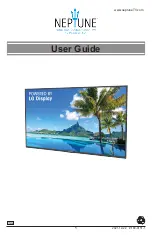
MEPS
−
Televisions April 2005
Page 4
A study produced for the Energy Efficiency and Conservation Authority by
Wise Analysis Ltd
Executive Summary
This report provides a New Zealand perspective on Australian proposals to introduce a MEPS
and comparative labelling scheme. It recommends that a MEPS and comparative labelling
scheme for televisions in New Zealand should be implemented in tandem with Australia. The
MEPS should cover both on-mode and standby energy consumption. The setting of MEPS
levels should be designed initially, as in Australia to encourage the removal of the 30% of
worst performing TVs from the marketplace, and to match the best practice levels of our
product source countries.
Since the scheme will probably now be voluntary, consultation with the importers and major
retailers will be necessary to ensure that there is no undue resistance to the scheme, to
maximise compliance and adherence to the principles of the scheme.
The most common form of television used in the residential sector in both New Zealand and
Australia is still the analogue colour TV using cathode ray tube technology. However the sales
volume of slimline televisions (LCD, plasma and rear projection) is increasing rapidly almost
doubling from 5.2 to 9.6% last year. The features offered by TVs now include 100 Hz picture
frequency, widescreen format, and stereo which all increase the power of the set. Another
significant change will be the introduction of digital television. Consumers with analogue sets
will have to purchase a set top box to convert digital broadcasts to analogue, although i
ntegrated
receiver decoder sets will come to market soon
.
New Zealand imports all of its TVs, and has done so since 1990-91, and Australia is also now
primarily an importer of televisions. The main source for New Zealand supply is China, with a
smaller number originating in Europe, Japan, and Korea.
The total number of TVs in New Zealand is estimated at 2,785,600, a 98% penetration. Of
these 590,200 are single TV households. The numbers of TVs currently sold each year is
currently 318,847 an increase of 25% on the previous year. The current economic life of
standard CRT style TVs is assessed as averaging 7 years.
The total energy use of TVs is estimated to be 320 GWh per year, which is of the order of 40%
of the annual energy increase for New Zealand of 800 GWh. Savings of 20% of this 320 GWh
over the next 5-7 years are expected to be achievable using some form of MEPS, and would
contribute significantly to lowering New Zealand’s energy growth profile. Standby power of
around 6W is also a significant contributor to the overall TV power use, and a reduction of
some 30% could be achieved, with a long term goal of less than 1W.
In Europe, there are a number of initiatives to encourage industry best practice through a
voluntary energy labelling scheme, which uses an Energy Efficiency Index. At least 20% of
analogue TVs already on the market in Europe comply with this index. Mandatory or
obligatory programs are the Japanese Top Runner program, and China is planning the
imminent introduction of a labelling and MEPS program within the next year. However
“business as usual” will also produce a natural reduction in energy usage for TVs of 2% per
year from savings due to design improvements by manufacturers.
It will be important to ensure that a New Zealand or Australasian MEPS scheme is compatible
with other national schemes that have a larger manufacturing or consumer base. It is
anticipated that contracts for TV purchase will have to include requirements for type testing
from overseas test laboratories and possibly labelling.








































